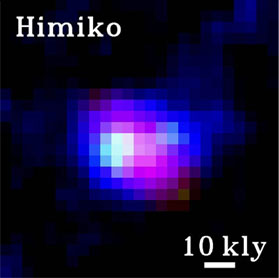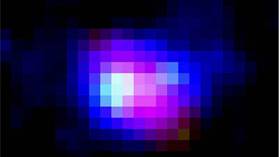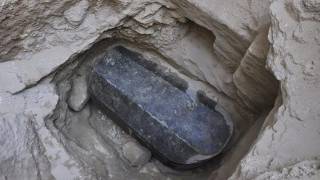Giant Mystery Blob Discovered Near Dawn of Time
Source: space.com

A newly found primordial blob may represent the most massive object ever discovered in the early universe, researchers announced today.
The gas cloud, spotted from 12.9 billion light-years away, could signal the earliest stages of galaxy formation back when the universe was just 800 million years old.
"I have never heard about any [similar] objects that could be resolved at this distance," said Masami Ouchi, a researcher at the Carnegie Institution in Pasadena, Calif. "It's kind of record-breaking."
A light-year is the distance light travels in a year, about 6 trillion miles (10 trillion kilometers). An object 12.9 billion light-years away is seen as it existed 12.9 billion years ago, and the light is just now arriving.
The cloud predates similar blobs, known as Lyman-Alpha blobs, which existed when the universe was 2 billion to 3 billion years old. Researchers named their new find Himiko, after an ancient Japanese queen with an equally murky past.
Himiko holds more than 10 times as much mass as the next largest object found in the early universe, or roughly the equivalent mass of 40 billion suns. At 55,000 light years across, it spans about half the diameter of our Milky Way Galaxy.
Lyman-Alpha blobs remain a mystery because existing telescopes have a hard time peering so far back to nearly the dawn of the universe.
Himiko sits right on the doorstep of an era called the reionization epoch, which lasted between 200 million and 1 billion years after the Big Bang. That's when the universe had just emerged from its cosmic dark ages and had begun brightening through the formation of stars and galaxies. Hot, energized hydrogen gas from that time period has allowed astronomers to begin seeing some objects — as much good as it does to squint at such fuzzy blobs.
"Even for astronomers, we don't understand," Ouchi told SPACE.com. "We are keen to try to understand what those systems are in the reionization epoch."
Himiko may represent an ionized gas halo surrounding a super-massive black hole, or a cooling gas cloud that indicates a primordial galaxy, Ouchi noted. But it might also be the result of a collision between two young galaxies, or the outgoing wind of a highly active star nursery, or a single giant galaxy.
Pinning down this riddle will require further telescope time. The W.M. Keck Observatory in Hawaii can help accurately estimate star formation in the blob, while NASA's Chandra X-ray Observatory could test the super-massive black hole scenario, Ouchi noted. And even Hubble could get in on the action.
"We're planning deep infrared imaging with the Hubble Space Telescope to tell whether [Himiko] has merger-like qualities or not," Ouchi said.
However, that particular research hinges upon the future success of a risky repair mission to the aging Hubble. Astronauts are slated to blast off with the space shuttle Atlantis in the attempt next month.
For now, researchers may celebrate the fact that they found Himiko at all. They almost overlooked the blob among 207 galaxy candidates, while sweeping a portion of the sky designated the Subaru/XMM-Newton Deep Survey Field.
After making the initial sighting with the Subaru telescope in Hawaii in 2007, Ouchi and his colleagues followed up using instruments from the Keck/DEIMOS and Magellan/IMACS arrays. Those spectrographic observations allowed them to pinpoint the signature of the ionized hydrogen gas and determine the distance and age of the mysterious Himiko.
"We never believed that this bright and large source was a real distant object," Ouchi said. "We thought it was a foreground interloper contaminating our galaxy sample. But we tried anyway."






















